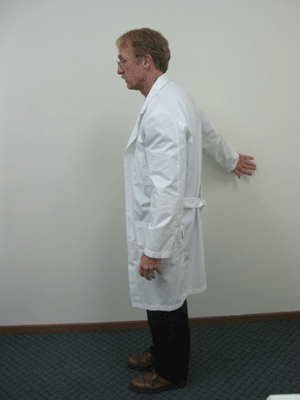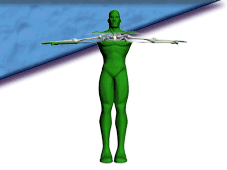The Best Excercies IV
Hip and Upper Leg Muscle Pain - ITB (Iliotibial Band) Roller This exercise requires the use of a firm but padded cylinder, such as a biofoam roller or a kitchen rolling
pin that is heavily padded with a towel or rubber material. Perform this exercise slowly and carefully,
as pressure directly applied to the problem area can be painful. You should allow enough pressure to
cause mild discomfort only.
This exercise requires the use of a firm but padded cylinder, such as a biofoam roller or a kitchen rolling
pin that is heavily padded with a towel or rubber material. Perform this exercise slowly and carefully,
as pressure directly applied to the problem area can be painful. You should allow enough pressure to
cause mild discomfort only.First, lie on the floor in a face-down position. Place the roller transversely across you pain-side leg just above your knee. Elevate your upper body with your arms as if starting to do a push-up. Now turn onto your pain side at the pelvis by rotating your hips. It is further recommended to plant the foot of the pain-free side on the floor in front of the problem leg, with that knee bent so that this pain-free leg is partially supporting along with both your arms. At this point the roller should be applying light pressure to the pain-side leg just above the knee. Continuing this light pressure, slowly "crawl" you hands on the floor toward the roller while maintaining the upper body elevation. This movement the roller to exert pressure onto your painful thigh, then hip. If the pain resulting is mild to moderate keep moving until you reach the upper limit of your hip. If the pain becomes too severe stop and crawl in the other direction so the roller pressure moves back downward away from that pain. Repeat the process, moving the pressure up and down the pain area for 10 repetitions. If your arms get tired take a break after fewer reps, then return to the exercises. Remember, this exercise is supposed to hurt a bit without being extremely painful or excruciating.
Elbow Tendonitis & Tennis Elbow Pain - Wall Slides
 This exercise is given for elbow pain located at the outside (lateral) elbow, but it may be done with slight
modification for pain at the inside (medial) elbow, as described. The outside elbow pain, which is most
common, is sometimes termed "tennis elbow" and the inside elbow pain is termed "golfer's elbow".
This exercise is given for elbow pain located at the outside (lateral) elbow, but it may be done with slight
modification for pain at the inside (medial) elbow, as described. The outside elbow pain, which is most
common, is sometimes termed "tennis elbow" and the inside elbow pain is termed "golfer's elbow".Stand with your pain side shoulder against the wall. For example, if the right is your painful elbow stand so that you are facing parallel to the wall with the outer right side of that shoulder against the wall. Now step away from the wall a few inches so that the shoulder no longer touches the wall. With arms hanging at your sides move the pain-side arm backward behind you and place the back of that hand flat on the wall. The elbow should be locked or slightly bent. This is the starting position for this tennis elbow stretch. For golfer's elbow just turn the hand so that the palm is flat on the wall. After that modification the exercise is the same for either problem. Now slide the hand upward on the wall until it reaches shoulder height or as high as your elbow and shoulder tension will permit (If you suspect that your shoulder tension and imbalance has something to do with your elbow pain you are totally correct- but that is a subject for another lecture). Now, keeping your hand flat on the wall, take a step forward and toward the wall so that your body moves toward the wall and forward. As you lunge your way in this direction your hand may slide forward a little on the wall and that is ok. You should continue in this direction until you feel a good stretch with mild discomfort in the elbow and probably somewhat in that shoulder also. You should feel as though the pull on your elbow is reaching the area that bothers you. Hold the stretch for one to five seconds, then, relax the pressure for one to five seconds. Repeat 10 to 20 times. Apply more stretch as your tolerance allows. Go for small improvements each session. Don't try to get this normal tendon length back all at once. After all, it took a very long time to develop the elbow problem which was growing without your knowing it.
The information contained herein is not intended to be a substitute for professional medical advice, diagnosis or treatment in any manner. Always seek the advice of your physician or other qualified health provider with any questions you may have regarding any medical condition.
Return to the Articles Page
Return to the Where's Your Pain? Page



